Performance Management System in a Small Manufacturing Company Report
VerifiedAdded on 2023/04/08
|10
|2476
|396
Report
AI Summary
This report examines the effectiveness of performance management systems within a small manufacturing company facing challenges with its current system. The report explores the advantages and disadvantages of performance management in such a context, emphasizing the importance of employee motivation and productivity. It delves into strategies for improving manager commitment, addressing the lack of engagement with the existing system, and recommends the implementation of a 360-degree feedback-based performance management system. The methodology employed involves a qualitative analysis of secondary sources, including business journals and articles, to evaluate the system's impact. The report highlights the benefits of performance management, such as improved employee motivation and identification of underperformers, while also acknowledging potential drawbacks like a lack of focus on other organizational elements and the potential for employee discouragement. The recommended 360-degree feedback system aims to enhance information gathering and reduce bias, ultimately improving the system's overall effectiveness by involving all stakeholders.

Running head: PERFORMANCE MANAGEMENT SYSTEM
Performance management system
Name of the student
Name of the university
Author note
Performance management system
Name of the student
Name of the university
Author note
Paraphrase This Document
Need a fresh take? Get an instant paraphrase of this document with our AI Paraphraser
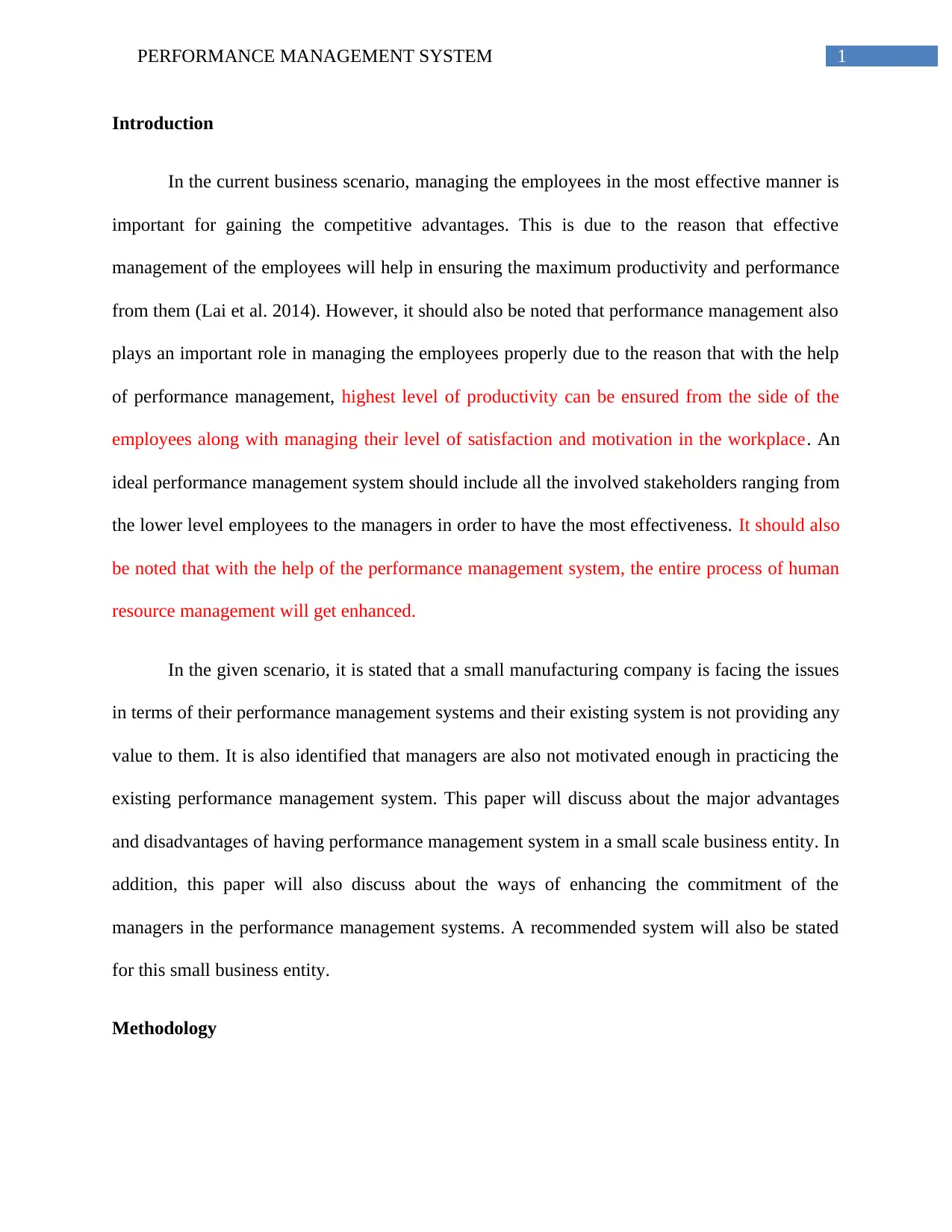
1PERFORMANCE MANAGEMENT SYSTEM
Introduction
In the current business scenario, managing the employees in the most effective manner is
important for gaining the competitive advantages. This is due to the reason that effective
management of the employees will help in ensuring the maximum productivity and performance
from them (Lai et al. 2014). However, it should also be noted that performance management also
plays an important role in managing the employees properly due to the reason that with the help
of performance management, highest level of productivity can be ensured from the side of the
employees along with managing their level of satisfaction and motivation in the workplace. An
ideal performance management system should include all the involved stakeholders ranging from
the lower level employees to the managers in order to have the most effectiveness. It should also
be noted that with the help of the performance management system, the entire process of human
resource management will get enhanced.
In the given scenario, it is stated that a small manufacturing company is facing the issues
in terms of their performance management systems and their existing system is not providing any
value to them. It is also identified that managers are also not motivated enough in practicing the
existing performance management system. This paper will discuss about the major advantages
and disadvantages of having performance management system in a small scale business entity. In
addition, this paper will also discuss about the ways of enhancing the commitment of the
managers in the performance management systems. A recommended system will also be stated
for this small business entity.
Methodology
Introduction
In the current business scenario, managing the employees in the most effective manner is
important for gaining the competitive advantages. This is due to the reason that effective
management of the employees will help in ensuring the maximum productivity and performance
from them (Lai et al. 2014). However, it should also be noted that performance management also
plays an important role in managing the employees properly due to the reason that with the help
of performance management, highest level of productivity can be ensured from the side of the
employees along with managing their level of satisfaction and motivation in the workplace. An
ideal performance management system should include all the involved stakeholders ranging from
the lower level employees to the managers in order to have the most effectiveness. It should also
be noted that with the help of the performance management system, the entire process of human
resource management will get enhanced.
In the given scenario, it is stated that a small manufacturing company is facing the issues
in terms of their performance management systems and their existing system is not providing any
value to them. It is also identified that managers are also not motivated enough in practicing the
existing performance management system. This paper will discuss about the major advantages
and disadvantages of having performance management system in a small scale business entity. In
addition, this paper will also discuss about the ways of enhancing the commitment of the
managers in the performance management systems. A recommended system will also be stated
for this small business entity.
Methodology
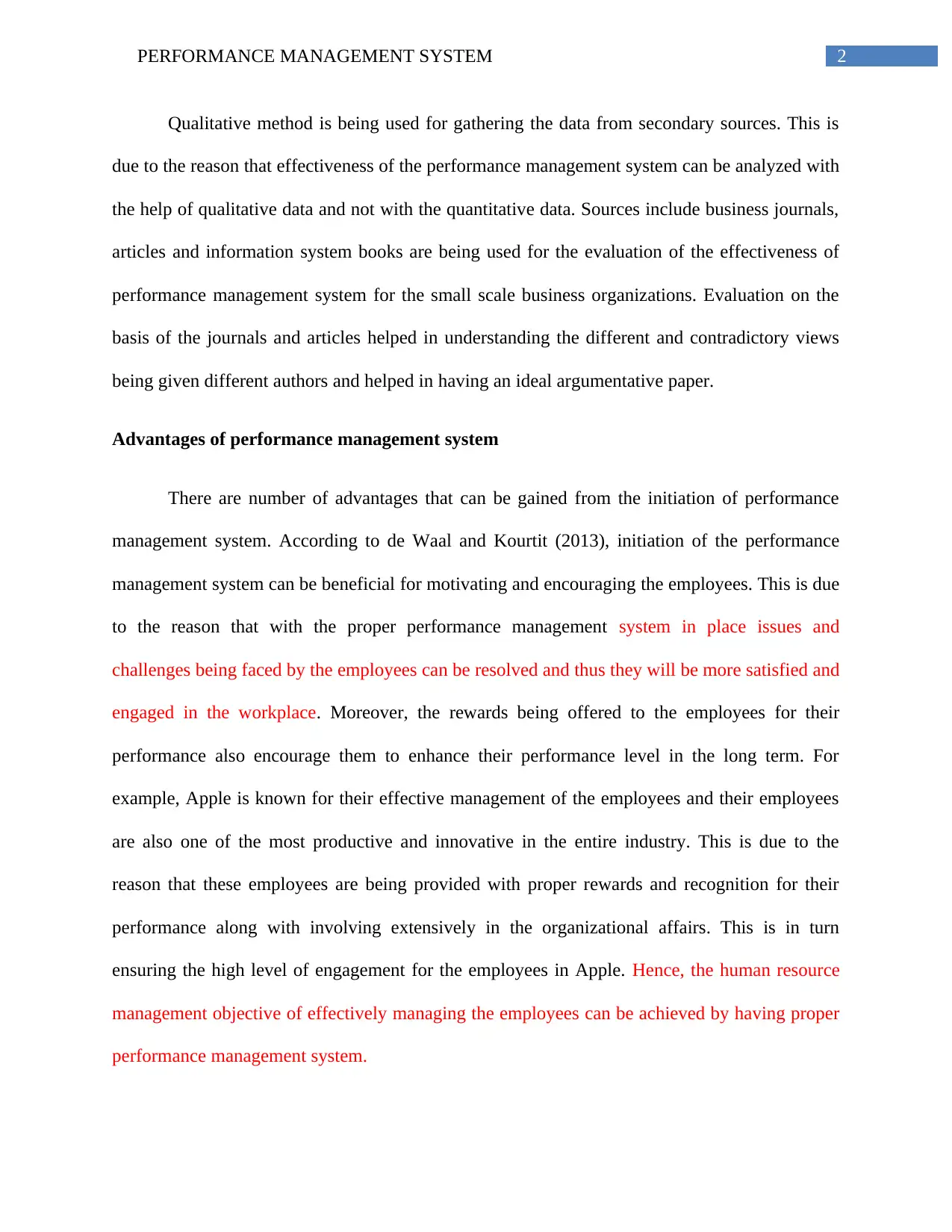
2PERFORMANCE MANAGEMENT SYSTEM
Qualitative method is being used for gathering the data from secondary sources. This is
due to the reason that effectiveness of the performance management system can be analyzed with
the help of qualitative data and not with the quantitative data. Sources include business journals,
articles and information system books are being used for the evaluation of the effectiveness of
performance management system for the small scale business organizations. Evaluation on the
basis of the journals and articles helped in understanding the different and contradictory views
being given different authors and helped in having an ideal argumentative paper.
Advantages of performance management system
There are number of advantages that can be gained from the initiation of performance
management system. According to de Waal and Kourtit (2013), initiation of the performance
management system can be beneficial for motivating and encouraging the employees. This is due
to the reason that with the proper performance management system in place issues and
challenges being faced by the employees can be resolved and thus they will be more satisfied and
engaged in the workplace. Moreover, the rewards being offered to the employees for their
performance also encourage them to enhance their performance level in the long term. For
example, Apple is known for their effective management of the employees and their employees
are also one of the most productive and innovative in the entire industry. This is due to the
reason that these employees are being provided with proper rewards and recognition for their
performance along with involving extensively in the organizational affairs. This is in turn
ensuring the high level of engagement for the employees in Apple. Hence, the human resource
management objective of effectively managing the employees can be achieved by having proper
performance management system.
Qualitative method is being used for gathering the data from secondary sources. This is
due to the reason that effectiveness of the performance management system can be analyzed with
the help of qualitative data and not with the quantitative data. Sources include business journals,
articles and information system books are being used for the evaluation of the effectiveness of
performance management system for the small scale business organizations. Evaluation on the
basis of the journals and articles helped in understanding the different and contradictory views
being given different authors and helped in having an ideal argumentative paper.
Advantages of performance management system
There are number of advantages that can be gained from the initiation of performance
management system. According to de Waal and Kourtit (2013), initiation of the performance
management system can be beneficial for motivating and encouraging the employees. This is due
to the reason that with the proper performance management system in place issues and
challenges being faced by the employees can be resolved and thus they will be more satisfied and
engaged in the workplace. Moreover, the rewards being offered to the employees for their
performance also encourage them to enhance their performance level in the long term. For
example, Apple is known for their effective management of the employees and their employees
are also one of the most productive and innovative in the entire industry. This is due to the
reason that these employees are being provided with proper rewards and recognition for their
performance along with involving extensively in the organizational affairs. This is in turn
ensuring the high level of engagement for the employees in Apple. Hence, the human resource
management objective of effectively managing the employees can be achieved by having proper
performance management system.
⊘ This is a preview!⊘
Do you want full access?
Subscribe today to unlock all pages.

Trusted by 1+ million students worldwide

3PERFORMANCE MANAGEMENT SYSTEM
Another major advantage of initiating performance management system is the
identification of the under performers in the workplace. According to Alegre, Sengupta and
Lapiedra (2013), with the help of the performance management, the employees not being able to
meet the targets and objectives can be easily identified and further actions can be taken. As per
the authors, identification of the underperforming employees is also important for
competitiveness due to the fact that these employees will reduce the organizational efficiency.
Further actions will include providence of proper training to the underperforming employees or
eliminating them. This can also benefit the organization in having lean and mean practices in
place. The major reason behind the lean practices of Toyota is their performance management
system. This is due to the reason that they maintains lean workforce with having higher
productivity and effectiveness level and the employees meeting their performance criteria can
only survive. This is helping Toyota to have a high performing process in place. The human
resource management objective of enhancing the workforce productivity can be fulfilled by the
effective process of performance management system.
Disadvantages of performance management system
One of the major disadvantages of performance management system mainly for the small
company is lack of focus on other different organizational elements. According to Bao et al.
(2013), small business entities are having lower resources to manage all the business factors
equally. Thus, with the initiation of performance management system, managers are more
concentrated towards meeting the goals and objectives and other factors such as employee
welfare are being overlapped. Small business entities are not having the capability to maintain all
the factors. Thus, initiation of the performance management system poses an added challenge for
them. For example, Purponics is a small scale business from Australia with having the strength
Another major advantage of initiating performance management system is the
identification of the under performers in the workplace. According to Alegre, Sengupta and
Lapiedra (2013), with the help of the performance management, the employees not being able to
meet the targets and objectives can be easily identified and further actions can be taken. As per
the authors, identification of the underperforming employees is also important for
competitiveness due to the fact that these employees will reduce the organizational efficiency.
Further actions will include providence of proper training to the underperforming employees or
eliminating them. This can also benefit the organization in having lean and mean practices in
place. The major reason behind the lean practices of Toyota is their performance management
system. This is due to the reason that they maintains lean workforce with having higher
productivity and effectiveness level and the employees meeting their performance criteria can
only survive. This is helping Toyota to have a high performing process in place. The human
resource management objective of enhancing the workforce productivity can be fulfilled by the
effective process of performance management system.
Disadvantages of performance management system
One of the major disadvantages of performance management system mainly for the small
company is lack of focus on other different organizational elements. According to Bao et al.
(2013), small business entities are having lower resources to manage all the business factors
equally. Thus, with the initiation of performance management system, managers are more
concentrated towards meeting the goals and objectives and other factors such as employee
welfare are being overlapped. Small business entities are not having the capability to maintain all
the factors. Thus, initiation of the performance management system poses an added challenge for
them. For example, Purponics is a small scale business from Australia with having the strength
Paraphrase This Document
Need a fresh take? Get an instant paraphrase of this document with our AI Paraphraser
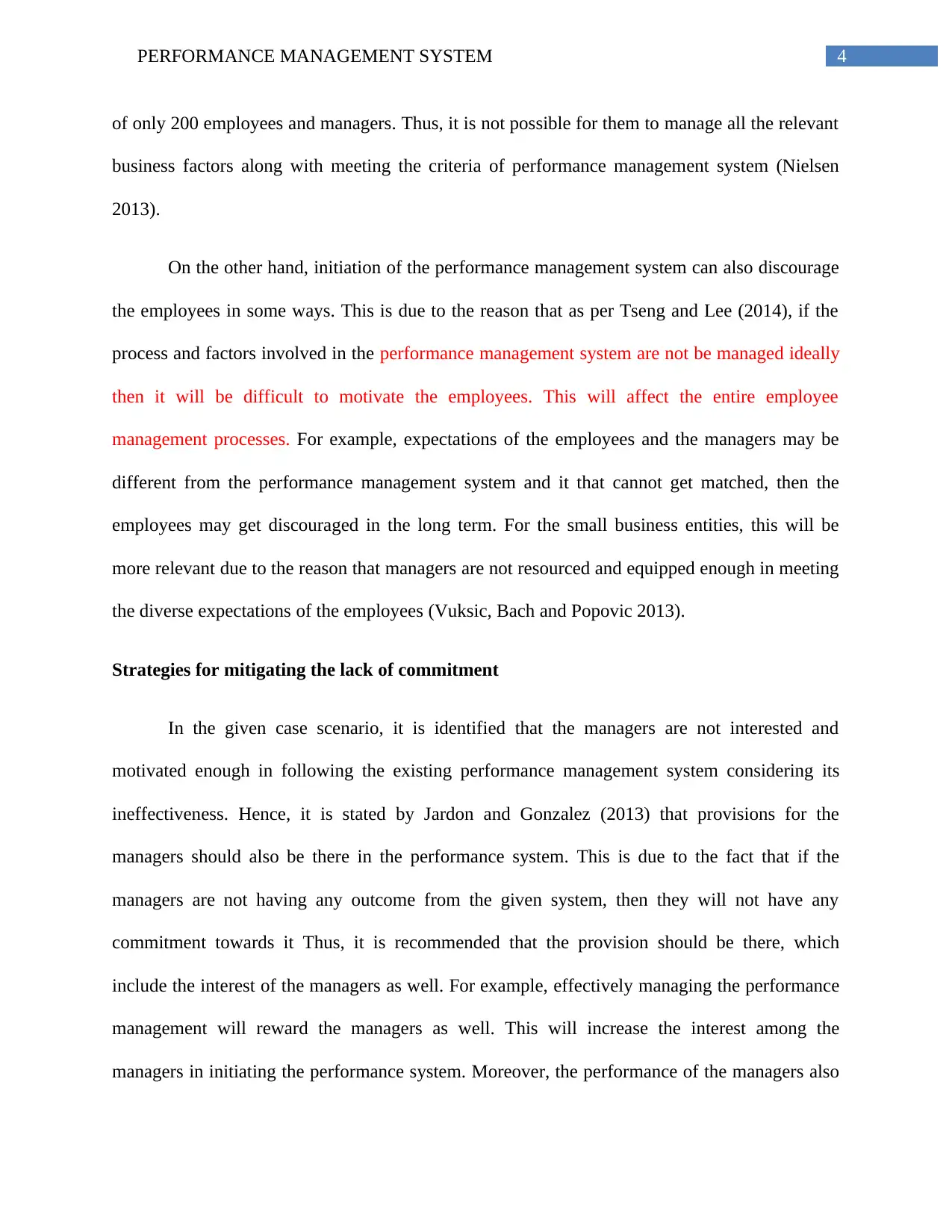
4PERFORMANCE MANAGEMENT SYSTEM
of only 200 employees and managers. Thus, it is not possible for them to manage all the relevant
business factors along with meeting the criteria of performance management system (Nielsen
2013).
On the other hand, initiation of the performance management system can also discourage
the employees in some ways. This is due to the reason that as per Tseng and Lee (2014), if the
process and factors involved in the performance management system are not be managed ideally
then it will be difficult to motivate the employees. This will affect the entire employee
management processes. For example, expectations of the employees and the managers may be
different from the performance management system and it that cannot get matched, then the
employees may get discouraged in the long term. For the small business entities, this will be
more relevant due to the reason that managers are not resourced and equipped enough in meeting
the diverse expectations of the employees (Vuksic, Bach and Popovic 2013).
Strategies for mitigating the lack of commitment
In the given case scenario, it is identified that the managers are not interested and
motivated enough in following the existing performance management system considering its
ineffectiveness. Hence, it is stated by Jardon and Gonzalez (2013) that provisions for the
managers should also be there in the performance system. This is due to the fact that if the
managers are not having any outcome from the given system, then they will not have any
commitment towards it Thus, it is recommended that the provision should be there, which
include the interest of the managers as well. For example, effectively managing the performance
management will reward the managers as well. This will increase the interest among the
managers in initiating the performance system. Moreover, the performance of the managers also
of only 200 employees and managers. Thus, it is not possible for them to manage all the relevant
business factors along with meeting the criteria of performance management system (Nielsen
2013).
On the other hand, initiation of the performance management system can also discourage
the employees in some ways. This is due to the reason that as per Tseng and Lee (2014), if the
process and factors involved in the performance management system are not be managed ideally
then it will be difficult to motivate the employees. This will affect the entire employee
management processes. For example, expectations of the employees and the managers may be
different from the performance management system and it that cannot get matched, then the
employees may get discouraged in the long term. For the small business entities, this will be
more relevant due to the reason that managers are not resourced and equipped enough in meeting
the diverse expectations of the employees (Vuksic, Bach and Popovic 2013).
Strategies for mitigating the lack of commitment
In the given case scenario, it is identified that the managers are not interested and
motivated enough in following the existing performance management system considering its
ineffectiveness. Hence, it is stated by Jardon and Gonzalez (2013) that provisions for the
managers should also be there in the performance system. This is due to the fact that if the
managers are not having any outcome from the given system, then they will not have any
commitment towards it Thus, it is recommended that the provision should be there, which
include the interest of the managers as well. For example, effectively managing the performance
management will reward the managers as well. This will increase the interest among the
managers in initiating the performance system. Moreover, the performance of the managers also
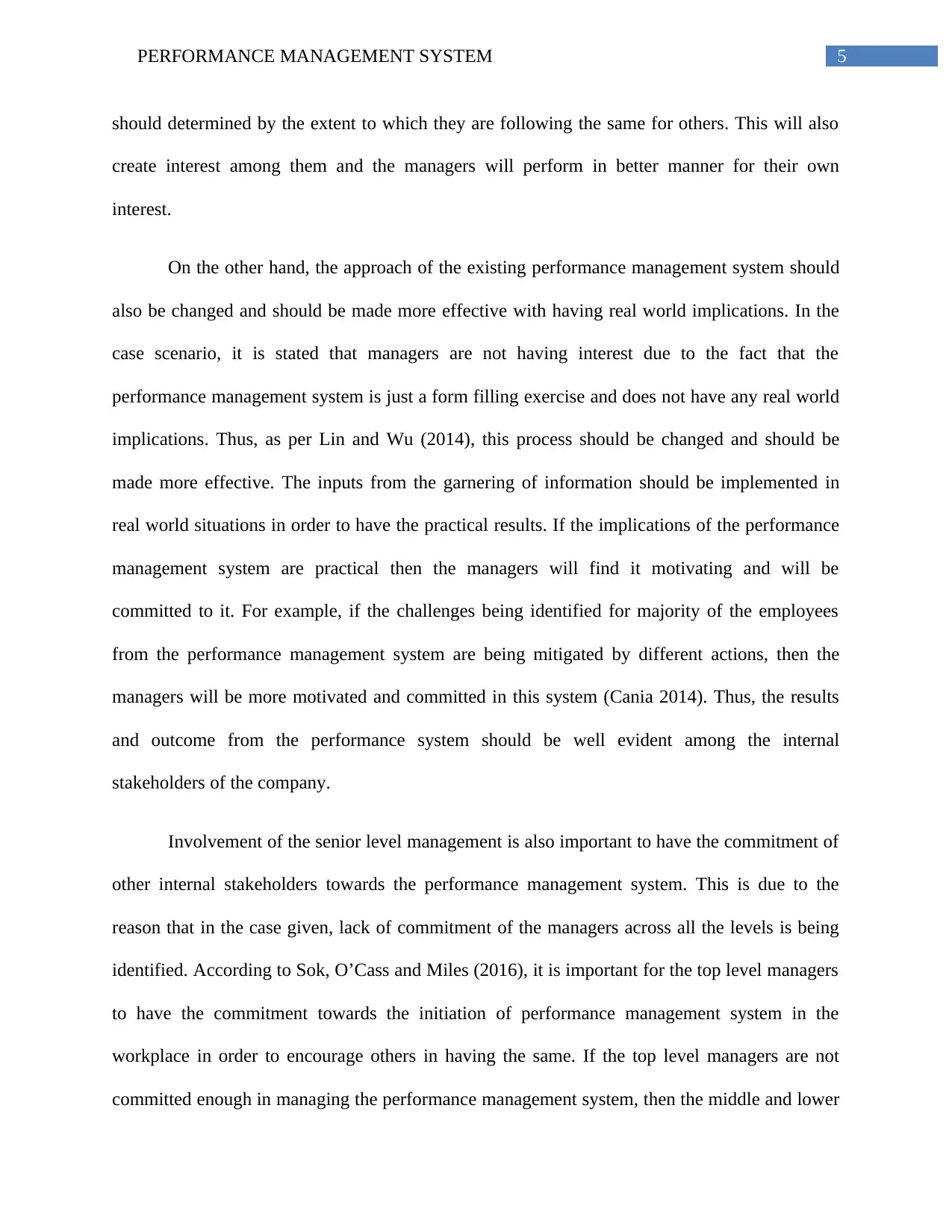
5PERFORMANCE MANAGEMENT SYSTEM
should determined by the extent to which they are following the same for others. This will also
create interest among them and the managers will perform in better manner for their own
interest.
On the other hand, the approach of the existing performance management system should
also be changed and should be made more effective with having real world implications. In the
case scenario, it is stated that managers are not having interest due to the fact that the
performance management system is just a form filling exercise and does not have any real world
implications. Thus, as per Lin and Wu (2014), this process should be changed and should be
made more effective. The inputs from the garnering of information should be implemented in
real world situations in order to have the practical results. If the implications of the performance
management system are practical then the managers will find it motivating and will be
committed to it. For example, if the challenges being identified for majority of the employees
from the performance management system are being mitigated by different actions, then the
managers will be more motivated and committed in this system (Cania 2014). Thus, the results
and outcome from the performance system should be well evident among the internal
stakeholders of the company.
Involvement of the senior level management is also important to have the commitment of
other internal stakeholders towards the performance management system. This is due to the
reason that in the case given, lack of commitment of the managers across all the levels is being
identified. According to Sok, O’Cass and Miles (2016), it is important for the top level managers
to have the commitment towards the initiation of performance management system in the
workplace in order to encourage others in having the same. If the top level managers are not
committed enough in managing the performance management system, then the middle and lower
should determined by the extent to which they are following the same for others. This will also
create interest among them and the managers will perform in better manner for their own
interest.
On the other hand, the approach of the existing performance management system should
also be changed and should be made more effective with having real world implications. In the
case scenario, it is stated that managers are not having interest due to the fact that the
performance management system is just a form filling exercise and does not have any real world
implications. Thus, as per Lin and Wu (2014), this process should be changed and should be
made more effective. The inputs from the garnering of information should be implemented in
real world situations in order to have the practical results. If the implications of the performance
management system are practical then the managers will find it motivating and will be
committed to it. For example, if the challenges being identified for majority of the employees
from the performance management system are being mitigated by different actions, then the
managers will be more motivated and committed in this system (Cania 2014). Thus, the results
and outcome from the performance system should be well evident among the internal
stakeholders of the company.
Involvement of the senior level management is also important to have the commitment of
other internal stakeholders towards the performance management system. This is due to the
reason that in the case given, lack of commitment of the managers across all the levels is being
identified. According to Sok, O’Cass and Miles (2016), it is important for the top level managers
to have the commitment towards the initiation of performance management system in the
workplace in order to encourage others in having the same. If the top level managers are not
committed enough in managing the performance management system, then the middle and lower
⊘ This is a preview!⊘
Do you want full access?
Subscribe today to unlock all pages.

Trusted by 1+ million students worldwide
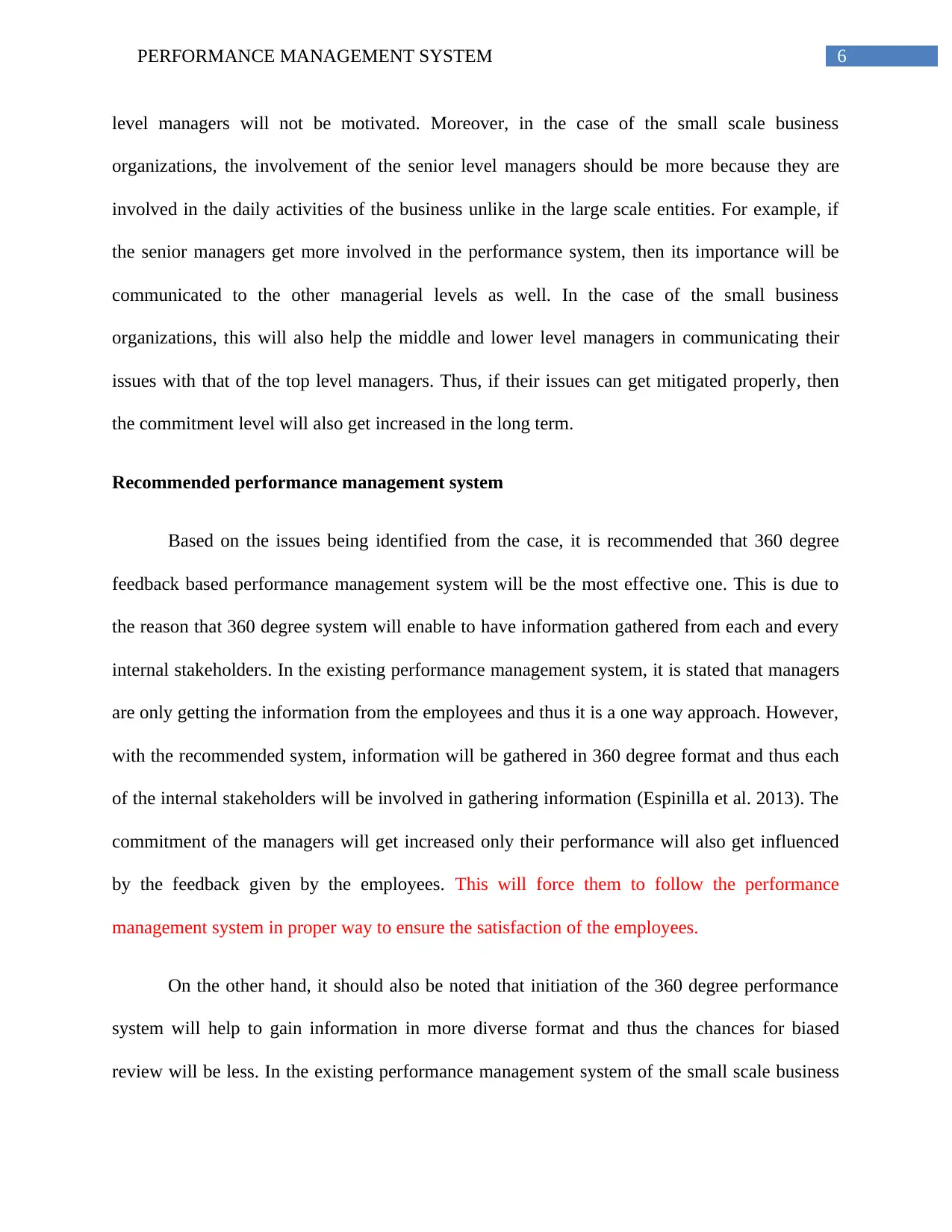
6PERFORMANCE MANAGEMENT SYSTEM
level managers will not be motivated. Moreover, in the case of the small scale business
organizations, the involvement of the senior level managers should be more because they are
involved in the daily activities of the business unlike in the large scale entities. For example, if
the senior managers get more involved in the performance system, then its importance will be
communicated to the other managerial levels as well. In the case of the small business
organizations, this will also help the middle and lower level managers in communicating their
issues with that of the top level managers. Thus, if their issues can get mitigated properly, then
the commitment level will also get increased in the long term.
Recommended performance management system
Based on the issues being identified from the case, it is recommended that 360 degree
feedback based performance management system will be the most effective one. This is due to
the reason that 360 degree system will enable to have information gathered from each and every
internal stakeholders. In the existing performance management system, it is stated that managers
are only getting the information from the employees and thus it is a one way approach. However,
with the recommended system, information will be gathered in 360 degree format and thus each
of the internal stakeholders will be involved in gathering information (Espinilla et al. 2013). The
commitment of the managers will get increased only their performance will also get influenced
by the feedback given by the employees. This will force them to follow the performance
management system in proper way to ensure the satisfaction of the employees.
On the other hand, it should also be noted that initiation of the 360 degree performance
system will help to gain information in more diverse format and thus the chances for biased
review will be less. In the existing performance management system of the small scale business
level managers will not be motivated. Moreover, in the case of the small scale business
organizations, the involvement of the senior level managers should be more because they are
involved in the daily activities of the business unlike in the large scale entities. For example, if
the senior managers get more involved in the performance system, then its importance will be
communicated to the other managerial levels as well. In the case of the small business
organizations, this will also help the middle and lower level managers in communicating their
issues with that of the top level managers. Thus, if their issues can get mitigated properly, then
the commitment level will also get increased in the long term.
Recommended performance management system
Based on the issues being identified from the case, it is recommended that 360 degree
feedback based performance management system will be the most effective one. This is due to
the reason that 360 degree system will enable to have information gathered from each and every
internal stakeholders. In the existing performance management system, it is stated that managers
are only getting the information from the employees and thus it is a one way approach. However,
with the recommended system, information will be gathered in 360 degree format and thus each
of the internal stakeholders will be involved in gathering information (Espinilla et al. 2013). The
commitment of the managers will get increased only their performance will also get influenced
by the feedback given by the employees. This will force them to follow the performance
management system in proper way to ensure the satisfaction of the employees.
On the other hand, it should also be noted that initiation of the 360 degree performance
system will help to gain information in more diverse format and thus the chances for biased
review will be less. In the existing performance management system of the small scale business
Paraphrase This Document
Need a fresh take? Get an instant paraphrase of this document with our AI Paraphraser

7PERFORMANCE MANAGEMENT SYSTEM
operation, review given by the managers will determine the performance evaluation of the
employees, which may be biased. However, the recommended system will not have the chances
for biasness and will also ensure that all the internal stakeholders are getting involved in the
system (Aggarwal and Thakur 2013). Enhancement of the involvement of the stakeholders also
ensures effectiveness of the system will get increased. This is due to the reason that the more will
be the involvement of the internal stakeholders in the system, the more will be the coverage of
the 360 degree performance management system in the organization. In the case of small scale
business operation, 360 degree performance management system will be effective due to the
reason that garnering of data from all the internal stakeholders will not be difficult as number
will be low. Hence, 360 degree feedback based performance management system will be most
effective for the small scale business entities.
Conclusion
This is to be concluded that there are number of limitations being identified from the
existing performance management system of the small scale business. These limitations are
being critically analyzed in this paper. In addition, the ways in which the commitment level of
the managers can be enhanced in following the performance management system are also being
discussed. It is identified that they should be more involved in the process in order to have
greater commitment. On the basis of these factors, it is recommended that 360 degree feedback
based performance management system should be followed. There are number of advantages
that can be gained from this system especially in the case of small scale business organizations.
These advantages are also being discussed in this paper. The key advantage that will be gained is
the higher set of involvement of all the internal stakeholders.
operation, review given by the managers will determine the performance evaluation of the
employees, which may be biased. However, the recommended system will not have the chances
for biasness and will also ensure that all the internal stakeholders are getting involved in the
system (Aggarwal and Thakur 2013). Enhancement of the involvement of the stakeholders also
ensures effectiveness of the system will get increased. This is due to the reason that the more will
be the involvement of the internal stakeholders in the system, the more will be the coverage of
the 360 degree performance management system in the organization. In the case of small scale
business operation, 360 degree performance management system will be effective due to the
reason that garnering of data from all the internal stakeholders will not be difficult as number
will be low. Hence, 360 degree feedback based performance management system will be most
effective for the small scale business entities.
Conclusion
This is to be concluded that there are number of limitations being identified from the
existing performance management system of the small scale business. These limitations are
being critically analyzed in this paper. In addition, the ways in which the commitment level of
the managers can be enhanced in following the performance management system are also being
discussed. It is identified that they should be more involved in the process in order to have
greater commitment. On the basis of these factors, it is recommended that 360 degree feedback
based performance management system should be followed. There are number of advantages
that can be gained from this system especially in the case of small scale business organizations.
These advantages are also being discussed in this paper. The key advantage that will be gained is
the higher set of involvement of all the internal stakeholders.
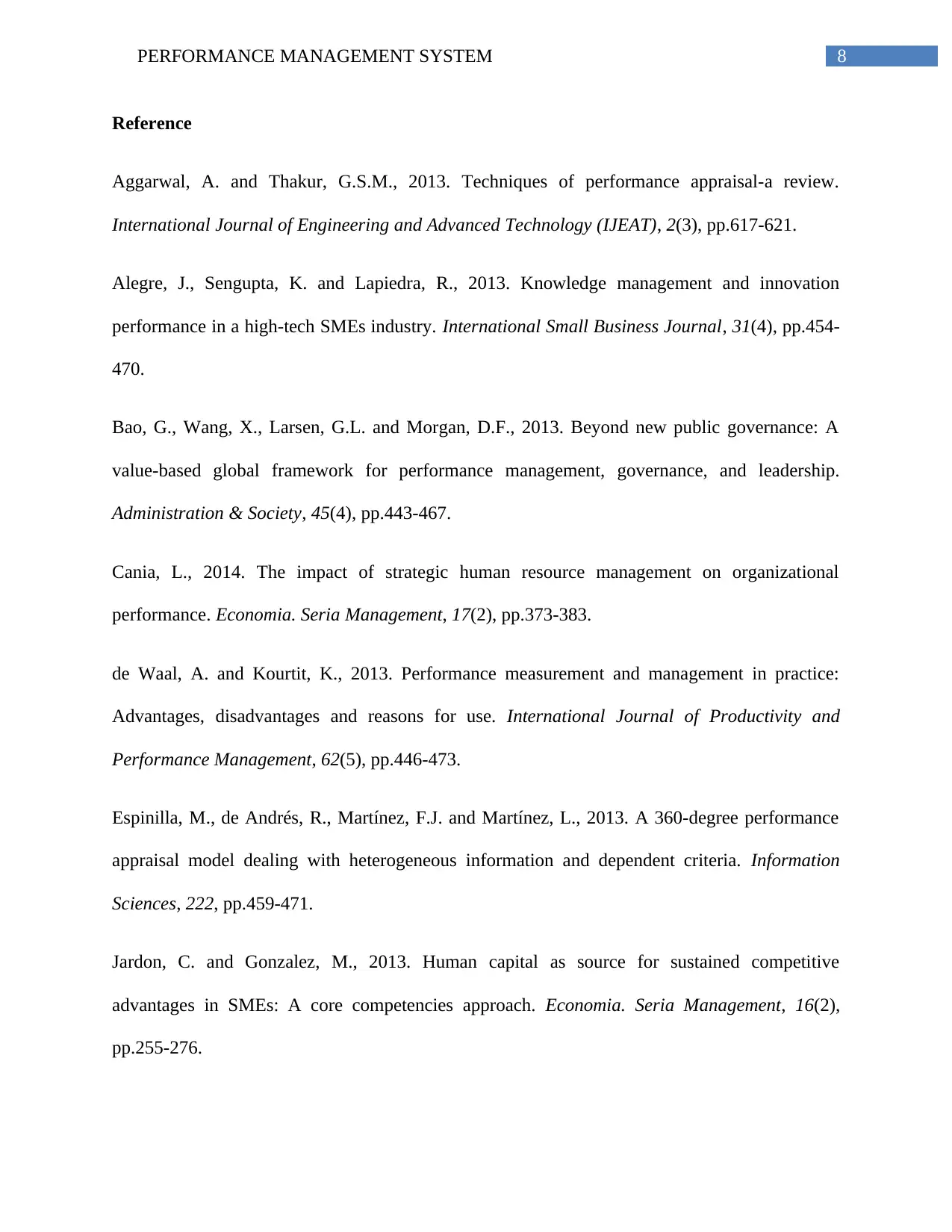
8PERFORMANCE MANAGEMENT SYSTEM
Reference
Aggarwal, A. and Thakur, G.S.M., 2013. Techniques of performance appraisal-a review.
International Journal of Engineering and Advanced Technology (IJEAT), 2(3), pp.617-621.
Alegre, J., Sengupta, K. and Lapiedra, R., 2013. Knowledge management and innovation
performance in a high-tech SMEs industry. International Small Business Journal, 31(4), pp.454-
470.
Bao, G., Wang, X., Larsen, G.L. and Morgan, D.F., 2013. Beyond new public governance: A
value-based global framework for performance management, governance, and leadership.
Administration & Society, 45(4), pp.443-467.
Cania, L., 2014. The impact of strategic human resource management on organizational
performance. Economia. Seria Management, 17(2), pp.373-383.
de Waal, A. and Kourtit, K., 2013. Performance measurement and management in practice:
Advantages, disadvantages and reasons for use. International Journal of Productivity and
Performance Management, 62(5), pp.446-473.
Espinilla, M., de Andrés, R., Martínez, F.J. and Martínez, L., 2013. A 360-degree performance
appraisal model dealing with heterogeneous information and dependent criteria. Information
Sciences, 222, pp.459-471.
Jardon, C. and Gonzalez, M., 2013. Human capital as source for sustained competitive
advantages in SMEs: A core competencies approach. Economia. Seria Management, 16(2),
pp.255-276.
Reference
Aggarwal, A. and Thakur, G.S.M., 2013. Techniques of performance appraisal-a review.
International Journal of Engineering and Advanced Technology (IJEAT), 2(3), pp.617-621.
Alegre, J., Sengupta, K. and Lapiedra, R., 2013. Knowledge management and innovation
performance in a high-tech SMEs industry. International Small Business Journal, 31(4), pp.454-
470.
Bao, G., Wang, X., Larsen, G.L. and Morgan, D.F., 2013. Beyond new public governance: A
value-based global framework for performance management, governance, and leadership.
Administration & Society, 45(4), pp.443-467.
Cania, L., 2014. The impact of strategic human resource management on organizational
performance. Economia. Seria Management, 17(2), pp.373-383.
de Waal, A. and Kourtit, K., 2013. Performance measurement and management in practice:
Advantages, disadvantages and reasons for use. International Journal of Productivity and
Performance Management, 62(5), pp.446-473.
Espinilla, M., de Andrés, R., Martínez, F.J. and Martínez, L., 2013. A 360-degree performance
appraisal model dealing with heterogeneous information and dependent criteria. Information
Sciences, 222, pp.459-471.
Jardon, C. and Gonzalez, M., 2013. Human capital as source for sustained competitive
advantages in SMEs: A core competencies approach. Economia. Seria Management, 16(2),
pp.255-276.
⊘ This is a preview!⊘
Do you want full access?
Subscribe today to unlock all pages.

Trusted by 1+ million students worldwide
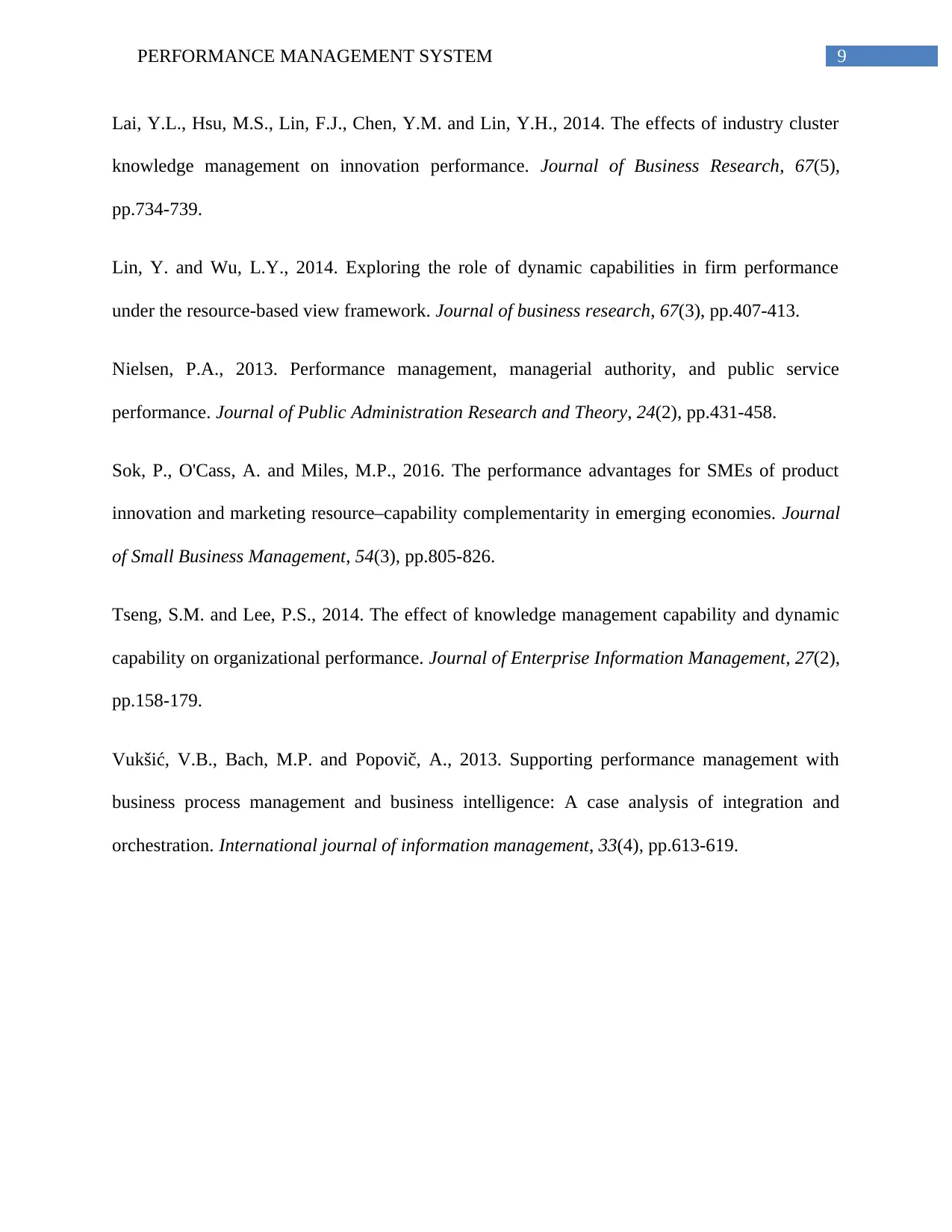
9PERFORMANCE MANAGEMENT SYSTEM
Lai, Y.L., Hsu, M.S., Lin, F.J., Chen, Y.M. and Lin, Y.H., 2014. The effects of industry cluster
knowledge management on innovation performance. Journal of Business Research, 67(5),
pp.734-739.
Lin, Y. and Wu, L.Y., 2014. Exploring the role of dynamic capabilities in firm performance
under the resource-based view framework. Journal of business research, 67(3), pp.407-413.
Nielsen, P.A., 2013. Performance management, managerial authority, and public service
performance. Journal of Public Administration Research and Theory, 24(2), pp.431-458.
Sok, P., O'Cass, A. and Miles, M.P., 2016. The performance advantages for SMEs of product
innovation and marketing resource–capability complementarity in emerging economies. Journal
of Small Business Management, 54(3), pp.805-826.
Tseng, S.M. and Lee, P.S., 2014. The effect of knowledge management capability and dynamic
capability on organizational performance. Journal of Enterprise Information Management, 27(2),
pp.158-179.
Vukšić, V.B., Bach, M.P. and Popovič, A., 2013. Supporting performance management with
business process management and business intelligence: A case analysis of integration and
orchestration. International journal of information management, 33(4), pp.613-619.
Lai, Y.L., Hsu, M.S., Lin, F.J., Chen, Y.M. and Lin, Y.H., 2014. The effects of industry cluster
knowledge management on innovation performance. Journal of Business Research, 67(5),
pp.734-739.
Lin, Y. and Wu, L.Y., 2014. Exploring the role of dynamic capabilities in firm performance
under the resource-based view framework. Journal of business research, 67(3), pp.407-413.
Nielsen, P.A., 2013. Performance management, managerial authority, and public service
performance. Journal of Public Administration Research and Theory, 24(2), pp.431-458.
Sok, P., O'Cass, A. and Miles, M.P., 2016. The performance advantages for SMEs of product
innovation and marketing resource–capability complementarity in emerging economies. Journal
of Small Business Management, 54(3), pp.805-826.
Tseng, S.M. and Lee, P.S., 2014. The effect of knowledge management capability and dynamic
capability on organizational performance. Journal of Enterprise Information Management, 27(2),
pp.158-179.
Vukšić, V.B., Bach, M.P. and Popovič, A., 2013. Supporting performance management with
business process management and business intelligence: A case analysis of integration and
orchestration. International journal of information management, 33(4), pp.613-619.
1 out of 10
Related Documents
Your All-in-One AI-Powered Toolkit for Academic Success.
+13062052269
info@desklib.com
Available 24*7 on WhatsApp / Email
![[object Object]](/_next/static/media/star-bottom.7253800d.svg)
Unlock your academic potential
Copyright © 2020–2025 A2Z Services. All Rights Reserved. Developed and managed by ZUCOL.





